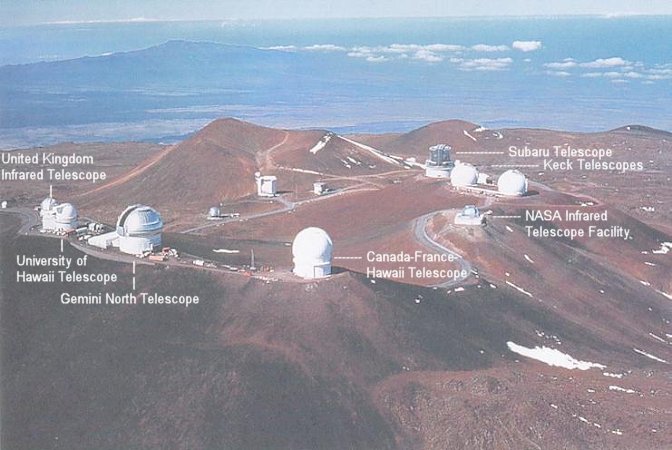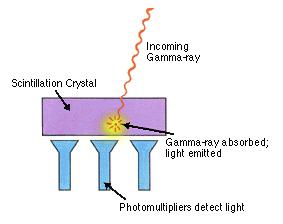 |
 |
much larger dimensions than lenses. Large lenses sage in the middle and distort the received image. Reflectors can also be made from a great variety of materials, because all that matters is the reflecting surface, whereas lenses have to be made from special types of glass. Figure 02 is the aerial view of Mauna Kea in Hawaii. It shows the domes that house many of the world's largest telescopes. |
Figure 01 Telescope, Types [view large image] |
Figure 02 Mauna Kea |
M = OF / f, -------------------- (1)
where OF is the focal length of the objective, and f that of the eyepiece.
The resolution (limit) of a telescope is given by the formula:
R (in sec of arc) = 2.3 x 105 x (
 /A), ------------------- (2)
/A), ------------------- (2)
where
 is the wavelength and A is the diameter of the aperture. For example, if A = 100 cm and
is the wavelength and A is the diameter of the aperture. For example, if A = 100 cm and  = 4000x10-8 (yellow light) then R = 0.092".
= 4000x10-8 (yellow light) then R = 0.092".Interferometer is used to measure the size of astronomical objects. By careful analysis of the resulting interference pattern, the position of a point source, or fine detail in an extended one, can be resolved. The same formula for the resolution above is applicable except the aperture A is replaced by the baseline between the two receivers. This technique has been used extensively with radio telescopes; it is now also applied to the optical telescopes as well.
The table below lists some of the optical telescopes in the world (a complete listing can be found in reference 1):
| Observatory | Location | Aperture (m) | Characteristics |
|---|---|---|---|
| Keck | Mauna Kea, Hawaii | 10.0 | 36 segment mirror |
| Keck II | Mauna Kea, Hawaii | 10.0 | Interferometry optical |
| Hobby-Eberly | Mt. Fowlkes, Texas | 9.2 | inexpensive, spectroscopy only |
| Subaru | Mauna Kea, Hawaii | 8.3 | Observational performance optimized |
| VLT (Very Large Telescope) | Cerro Paranal, Chile | 8.2 | 4 units combined as an interferometer |
| Gemini North | Mauna Kea, Hawaii | 8.1 | Twin of Gemini South |
| Gemini South | Cerro Pachon, Chile | 8.1 | All sky coverage with Gemini North |
| Next Generation Space Telescope | Halo orbit | 7 - 9 | Scheduled for launch in 2007 |
| Hale | Mt. Palomar, Ca. | 5.0 | Previous generation (1950-1990) limit |
| New Technology | Cerro La Silla, Chile | 3.5 | Adaptive opticsa |
| Hooker | Mt. Wilson, Ca. | 2.5 | Discovery of cosmic expansion (1917) |
| Hubble Space Telescope | Low Earth orbit | 2.4 | Observations outside the atmosphere |
| Solar Tower | Kitt Peak, Arizona | 1.8 | Study of the Sun |
| Yerkes | Williams Bay, Wisconsin | 1.0 | World's largest refractor (1897) |
Table 01 Optical Telescopes
[Top]
Radio Telescopes
 |
|
Figure 03 Interferometer |
[view large image] |
| Observatory | Location | Resolution (arcsec) | Characteristics |
|---|---|---|---|
| VLBI | Intercontinental | > 0.001 | Very Long Baseline Interferometer |
| VLA | Socorro, NM | > 0.04 | Largest (dish) synthesis array |
| Arecibo | Puerto Rico | > 0.2 | Largest fixed dish |
| Effelsberg | Effelsberg, Germany | > 0.6 | Largest single dish |
| Parkes | NSW, Australia | > 0.9 | Largest in southern hemisphere |
Table 02 Radio Telescopes
[Top]
Infrared Telescopes
 |
 |
of the instruments themselves, since object which is not at absolute zero, emits infrared radiation. So everything around the instruments (including the telescope) produces "backround noise". Therefore, special photo- graphic film is used to produce a "thermograph" of a |
Figure 04 Atomspheric Absorption [view large image] |
Figure 05 Infrared Telescope[view large image] |
celestial body, and the instruments must be cooled continuously by immersion in liquid nitrogen or helium (Figure 05). |
| Observatory | Location | Aperture (m) | Date |
|---|---|---|---|
| UKIRT | Mauna Kea, Hawaii | 3.8 | Since 1978 |
| FIRST | Orbiting | 3.0 | To be launched in 2007 |
| NASA IRTF | Mauna Kea, Hawaii | 3.0 | Since 1979 |
| SOFIA | Airborne | 2.5 | Scheduled for 2004 |
| SIRTF | Heliocentric orbit | 0.85 | Launched in August, 2003 |
| ISO | Geocentric orbit | 0.6 | Launched in November, 1995 |
| IRAS | Geocentric orbit | 0.6 | Operated for ten months in 1983 |
Table 03 Infrared Telescopes
Acronym: UKIRT - United Kingdom Infrared Telescope.FIRST - Far Infrared Space Telescope.
IRTF - Infrared Telescope Facility.
SOFIA - Stratosphere Observatory for Infrared Astronomy.
SIRTF - Space Infrared Telescope Facility; renamed to Spitzer Space Telescope in honor of the late
astrophysicist Lyman Spitzer Jr., who first conceived of a large telescope in orbit.
ISO - Infrared Space Observatory.
IRAS - Infrared Astronomical Satellite.
[Top]
High Frequency Observations
 |
 |
|
Figure 06 Grazing Telescope [view large image] |
Figure 07 Scintillator |
X-rays are typically emitted by gaseous bodies with temperatures ranging from 106 to 108 oK. Conventional telescopes cannot be used at x-ray (or EUV) wavelengths because mirrors abosrb x-rays rather than reflect them, unless the x-rays graze the surface at a very shallow angle. Satellites such as ROSAT (in orbit between 1990-1999), and the Chandra X-ray observatory (since July, 1999) utilize "grazing incidence" telescopes (GRITs), which bring x-rays to a focus by reflecting them at shallow angles from the surfaces of nested sets of tapering, tubelike reflectors as shown in Figure 06. X-ray observations have discovered a variety of objects, ranging from hot patches and cool "holes" in the Sun's outer atmosphere to swirling discs of hot gas surrounding collapsed stars and black holes to hot clouds of gas in intergalactic space.
Gamma rays are the most energetic form of electromagnetic radiation. Because their wavelengths are far smaller than the sizes of the atoms in a mirror, gamma rays cannot be focued by reflection, and the early gamma-ray satellites were unable to form images of sources or even determine their positions with confidence. Modern gamma-ray imaging systems and spectrometers, such as those carried on board the Compton Gamma Ray Observatory (CGRO, 1991-2000), make use of scintillators (see Figure 07), which are devices that convert gamma rays into visible photons that are more easily detected and analyzed. Among known gamma-ray sources are the Milky Way, some pulsars, and some quasars. Most puzzling of all are the 2600 gamma-ray bursts detected by CGRO. The next generation gamma-ray observatory is GLAST (Gamma-ray Large Area Space Telescope) scheduled to be launched in 2005. It is designed for making observations of celestial gamma-ray sources in the energy band extending from 20 MeV to more than 300 GeV.
Footnotes:
aIn adaptive optics, light from the primary mirror is directed onto a smaller flexible mirror behind which a large number of actuators are located. The actuators distort the shape of the mirror to cancel out distortions in the incoming wavefronts of light that have been caused by the atmosphere. Wavefront distortions are sensed by monitoring a suitable bright star, or an artificial "star" generatged by shining a powerful laser beam into the upper atmosphere. All these operations are computerized. Computers have so revolutionized astronomy, in fact, that researchers rarely look through the telescope or work in the dome during observations. Instead, they operate the instrument in comfort from a control room.- A complete listing of the World's Largest Optical Telescopes -- http://www.seds.org/billa/bigeyes.html